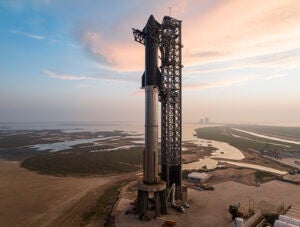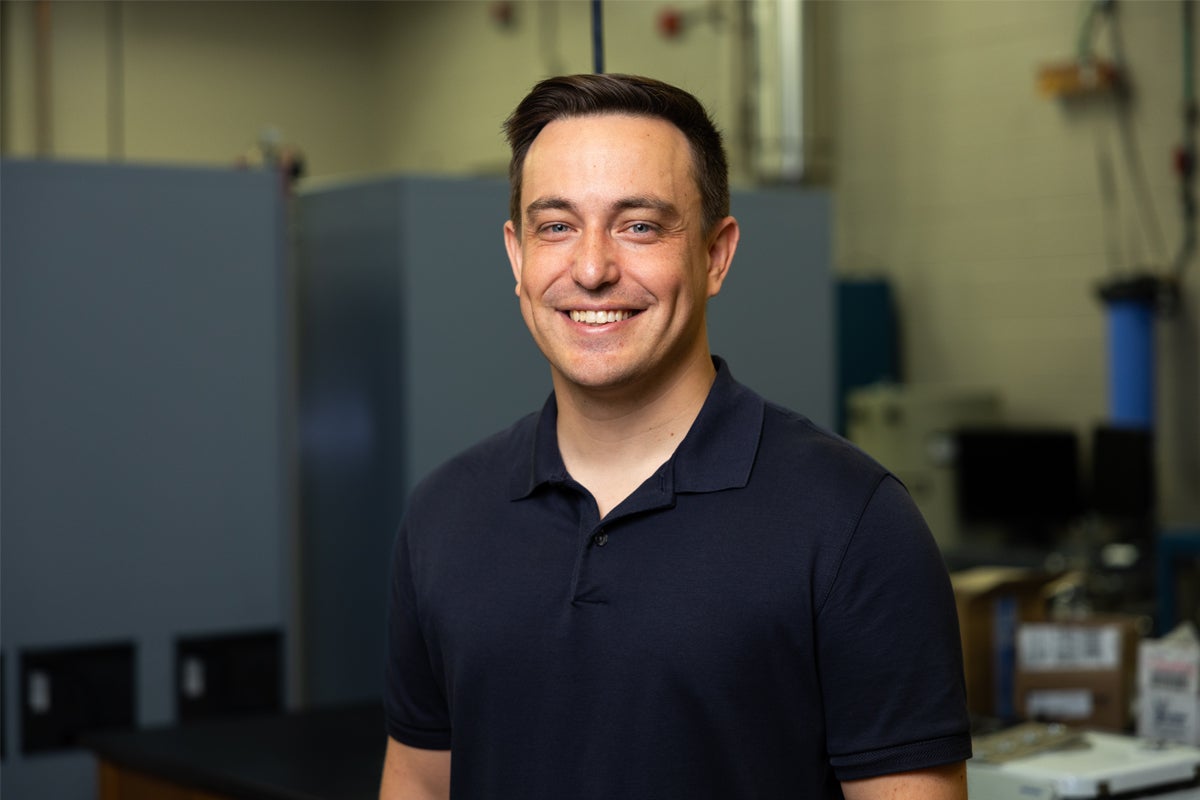Scientists at UCF are gathering valuable data for humanity’s next venture back to the moon and even for potential lunar settlements.
UCF physics doctoral candidate Brandon Dotson and Florida Space Institute planetary scientist Phil Metzger ’00MS ’05PhD analyzed rock samples from the first SpaceX Starship rocket launch in April 2023 that triggered a unique reaction causing the concrete launchpad to explode and eject material up to six miles away. The blast left a crater where the rocket had been because there was no water suppression or cooling method for the launchpad.
In a paper presented in April at the 2024 American Society of Civil Engineers Earth and Space Conference, Dotson and Metzger explained that the large rocket’s exhaust superheated the sand underneath the launchpad causing a reaction similar to a volcanic eruption. Sand particles were lofted and accelerated by vaporization of groundwater from the rocket exhaust and were carried away to the nearby town of Port Isabel, Texas.
Their unique findings may offer context for not just further Earth-based rocket launches, but also lunar-based launches, Dotson says. The knowledge gained from the launchpad’s destruction can provide information about variables related to reducing ejected material on the moon, such as vehicle size, launchpad material and cooling methods, he says.
“A lot of folks around the country are studying this problem of how you land and launch a rocket from a dusty, low gravity vacuum environment of the moon,” Dotson says. “I think this research gives us some insights into those models of what we can expect for spacecraft of this size. It helps inform the designs that we’re going to use eventually on the moon once we start to build those more permanent lunar infrastructure pieces. I think as we look at building landing or launchpads on the moon, if we start to build a base, this launch kind of shows us the importance of having maybe breathable launch pads to avoid that huge pressure build up underneath a launchpad.”

According to SpaceX, its Starship spacecraft and Super Heavy rocket — collectively referred to as Starship — is a 400-foot tall two-stage reusable rocket system designed to carry cargo and up to 100 people into space. Starship is scheduled for use in NASA’s Artemis III and IV missions.
SpaceX has performed three more Starship test launches since the initial test last April, and SpaceX is anticipating a fifth launch later this year, according to SpaceX CEO Elon Musk.
The Earth-based launches are useful for determining the capabilities of Starship as it prepares for future missions and to better understand more complicated launch scenarios, Dotson says.
“That launch tells us a lot about launching a large vehicle of that class on Earth,” he says. “Eventually, we’re hoping to get to the point where we’re launching those super heavy class rockets all the time, and eventually on more complicated planetary surfaces like the moon. Not having an atmosphere on the moon is a big deal. When you kick up dust, there’s no atmosphere to slow that dust down. You also can’t rely on the atmosphere to help slow you down like you could on Earth with a parachute. And you also have much less gravity, so you don’t have gravity pulling dust back down to the surface either.”
The Starship launch provided scientists a rare opportunity to study the failure mechanism, Dotson says
“It’s not like that happens every day,” he says. “So, we try to learn as much as we can from those instances and see what the data tell us.”
How the Study was Performed
Metzger, Dotson and collaborators from Rice University collected samples from private citizens in Port Isabel who experienced some of the peculiar sand “raining” down on them.
They were particularly concerned that they materials may be toxic, says Metzger, who coordinated sample collection through the social platform X.
“There was a lot of interest in the news on if it was hazardous,” he says. “We put a call out on [X, formerly known as Twitter] and people over there sent us samples. Brandon took the lead on the study from there.”
Dotson and Metzger determined the materials were nontoxic and were not sizable enough to be considered a respiration hazard.
After careful study, the reaction that caused the launchpad explosion is like a volcanic cap rock explosion and resulted in a unique mixture of groundwater, exhaust and sand, Metzger says.
“It looked like raindrops on the windshield,” he says. “We realized this dust and the sand must be mixed in rain. Rocket exhaust is mostly water and carbon dioxide from the Starship, and so it was literally a cloud of water droplets made by the rocket and so the sand that was under the launchpad was shot up into the cloud. Because it was a hot cloud, it had circulation in it, and it was the circulation that kept the sand from falling out.”
The raindrops were big enough that they fell out of the cloud and then dropped the sand far away, Metzger says. The people reported it felt like rain but was completely dry because it was so hot the rain was mostly vaporizing faster than it was hitting the ground, he says.
The next step is to figure out how to eliminate or significantly reduce the chance of failure so that rockets won’t damage surrounding infrastructure on Earth or the lunar surface, Metzger says.
“If you get cracks in the lunar launcher landing pad then the rocket exhaust will drive high pressure gas under the pad,” he says. “In the polar regions of the moon, there’s ice in the soil and that amount of ice that would be turning into vapor is comparable to the amount of groundwater that was involved with Starship’s launchpad. You could have a similar event occurring on the moon where you explode the launchpad and blow particulate matter to surrounding hardware, damaging the habitat, communication or power systems at an outpost.”
Metzger says he and other scientists are investigating how to vent — or otherwise mitigate — accumulated gas under a launchpad so that future missions are successful.
Researchers’ Credentials
With almost 30 years of experience at NASA, Metzger has been helping to make the dream of space travel a reality. The planetary scientist started as part of the Space Shuttle team after college. Metzger joined UCF’s Florida Space Institute in 2014 as a research professor in planetary science and space technology, and in 2023 became director of The Stephen W. Hawking Center for Microgravity Research and Education. He researches asteroid, lunar and Martian regolith and exploration technology. He has also developed small spacecraft technology to mine and use water for steam propulsion. A UCF Knight through and through, Metzger holds a doctorate and master’s degree in physics from UCF.
Dotson is a UCF doctoral candidate pursuing a degree in physics with a planetary science track. His research focuses on plume surface interaction and how rocket exhausts interact with planetary surfaces. Dotson also holds a master’s degree in physics from the California Institute of Technology and a master’s degree in aerospace engineering from the Georgia Institute of Technology.




